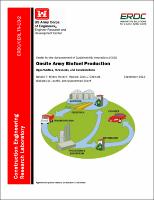Please use this identifier to cite or link to this item:
https://hdl.handle.net/11681/13811Full metadata record
| DC Field | Value | Language |
|---|---|---|
| dc.contributor | Center for the Advancement of Sustainability Innovations (U.S.) | - |
| dc.contributor.author | Myers, Natalie R. D. | - |
| dc.contributor.author | Howard, Heidi R. | - |
| dc.contributor.author | Gebhart, Dick L. | - |
| dc.contributor.author | Josefik, Nicholas M. | - |
| dc.contributor.author | Sharīf, Muhammad | - |
| dc.date.accessioned | 2016-09-28T16:10:38Z | - |
| dc.date.available | 2016-09-28T16:10:38Z | - |
| dc.date.issued | 2013-09 | - |
| dc.identifier.uri | http://hdl.handle.net/11681/13811 | - |
| dc.description | Technical Note | - |
| dc.description | Abstract: Energy crops are a potentially inexpensive, renewable fuel source for the Army that will also meet net-zero energy goals. Currently, there is no guidance on the production of biofuel crops within the DoD. Independent studies address other aspects of bioenergy crops, but none directly addresses the risks and tradeoffs associated with this alternative on Army lands. Portions of Army lands are viewed as compatible with oilseed and cellulosic feedstock crops, including roadside and utility rights-of-way, drop zones, storage and maintenance areas, and managed open spaces. Since conventional farming equipment and agricultural practices can be used, implementation of oilseed and cellulosic feedstock crops on these lands can be rapid (2-4 years). However, significant negative impacts often result from the conversion of marginal and/or previously uncultivated lands into cropland supporting biofuel production. Given this paradox, what has not been considered is establishing a way forward for installations to integrate bioenergy crops into the local ecosystem and Army mission. REAP and KDF modeling environments provide this opportunity, whereby site-specific geographic, environmental, installation infrastructure, business, and economic resource inputs can be used to identify constraints that might impact successful participation in regional biofuels production, transportation, processing, and distribution systems. | - |
| dc.publisher | Construction Engineering Research Laboratory (U.S.) | - |
| dc.publisher | Engineer Research and Development Center (U.S.) | - |
| dc.relation | http://acwc.sdp.sirsi.net/client/en_US/search/asset/1033263 | - |
| dc.rights | Approved for public release; distribution is unlimited. | - |
| dc.source | This Digital Resource was created in Microsoft Word and Adobe Acrobat | - |
| dc.subject | Alternative energy | - |
| dc.subject | Biofuels | - |
| dc.subject | CASI | - |
| dc.subject | Land management | - |
| dc.subject | Net-zero energy | - |
| dc.subject | Renewable energy | - |
| dc.subject | Army installations | - |
| dc.subject | Army lands | - |
| dc.subject | Environment | - |
| dc.title | Onsite Army biofuel production: opportunities, thresholds, and considerations | - |
| dc.type | Report | en_US |
| Appears in Collections: | Technical Note | |
Files in This Item:
| File | Description | Size | Format | |
|---|---|---|---|---|
| ERDC-CERL-TN-13-2.pdf | 2.07 MB | Adobe PDF |  View/Open |